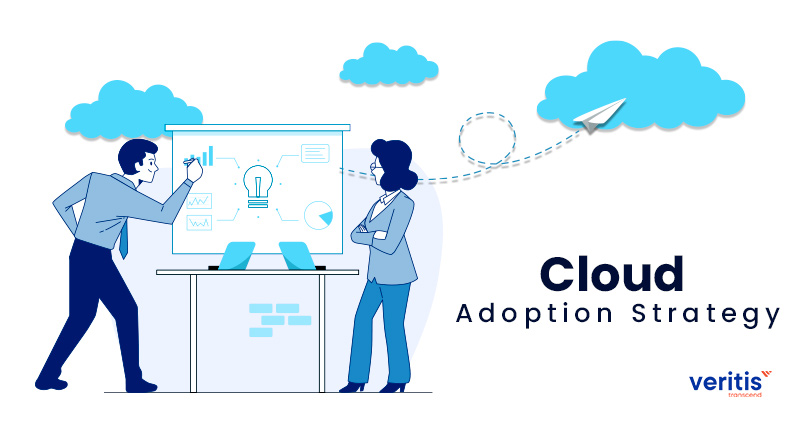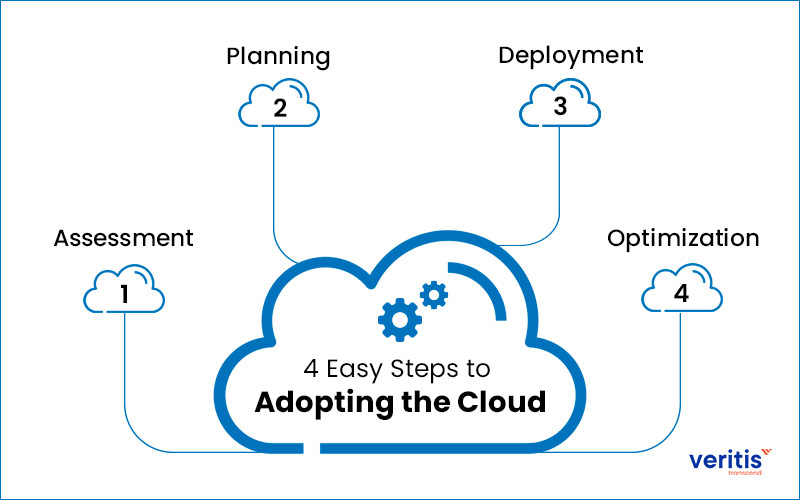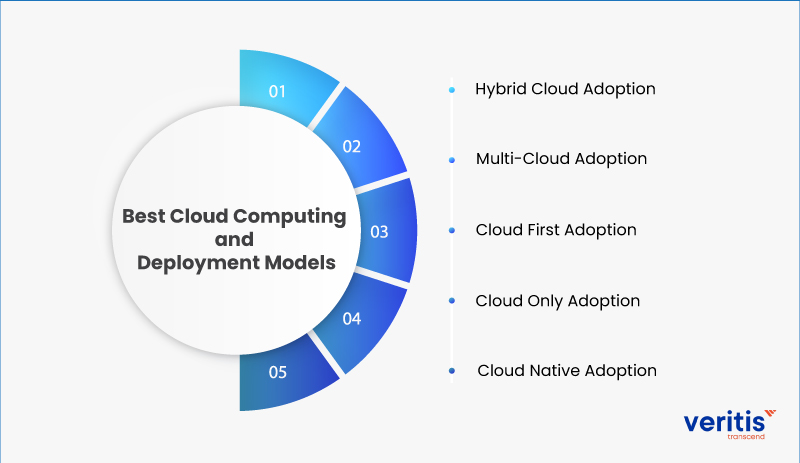
Table of contents
Most IT departments increasingly use the cloud as their primary platform when looking for practical solutions to meet business requirements; it is no longer just an idealistic goal for many enterprises. Cloud migration is a difficult step in digital transformation for these enterprises.
Many companies have implemented cloud technology gradually, focusing on specific requirements as they appear. The business may have chosen cloud strategies in some instances without consulting the IT group. Organizations are vulnerable to “cloud sprawl” without a centralized strategy for adopting the cloud, which raises costs and may cause compliance and security problems.
If various divisions exist within your company, make separate agreements to purchase cloud services. Then you most likely aren’t getting the bulk discounts you could. For instance, some cloud business model offers reserved instances or SaaS seats. As a result, you can waste money on situations that are no longer needed after serving their original function. Furthermore, duplicate or shadow cloud services make enforcing security regulations and demonstrating compliance more difficult.
“Cloud usage is becoming more popular than ever among businesses. In fact, according to Gartner, 85% of businesses will be “cloud-first” by 2025. Cloud adoption is essential to practically any growth strategy due to the demand to work remotely, decrease overhead expenses, offer clients better service, and compete with the market.”
“Many companies find that moving to the cloud is beneficial: McKinsey and Company said that in 61% of organizations that did so as part of their digital transformation, revenue increased by at least 25%.”
A learning curve is necessary to adopt the cloud best practices, whether private, public, or hybrid. Organizations must develop the necessary skills and expertise to create the procedures for ongoing operations. Those who don’t frequently discover that their efforts don’t result in the predicted revenue growth.
CIOs should focus on creating and implementing a cloud business model solution as the basis for regulating cloud strategies throughout the business and IT organization to address these issues. Business strategy must initially guide this cloud approach. However, the IT operations team should actively participate in developing it because poorly executed cloud strategy services might result in complexity, limiting agility and raising expenses.
Let’s briefly discuss the many forms of cloud computing strategy currently available before we examine the intricacies of the various cloud adoption tactics.
- Amazon Web Services (AWS), Microsoft Azure, and Google Cloud are the three main hyper scalers or public cloud providers. It is abundantly evident that the usage of cloud computing strategy is on the rise, as seen by the three providers’ rapid rise during the last five years.
- Additionally, a variety of computing models are used to supply cloud services, including Platform as a Service (PaaS), Infrastructure as a Service (IaaS), and software as a service (SaaS).
The cloud can also use with various deployment architectures, including private cloud, public cloud, hybrid cloud, multi cloud, or combinations of those. However, it would help if you start by addressing a straightforward question: “Why do I need to use the cloud?” before deciding which of these solutions is the greatest fit for your cloud adoption approach.
Why Cloud?

Understanding your company’s migration to the cloud is essential for the success of the cloud adoption framework.
The first step for anyone intending to implement cloud computing technologies successfully is clearly defining the business requirements and anticipated business outcomes. Unfortunately, due to cost inflation and other issues, many unplanned cloud adoptions run the danger of failing. Furthermore, the credibility of the IT departments within the company may suffer irreparable harm due to a poorly managed move.
Start by asking “Why?” if you want to avoid such outcomes. What makes the cloud necessary?
- Is your firm no longer able to afford the costs of on-premises deployment?
- Is your company looking to lower business risk using the cloud’s improved infrastructure availability and reliability?
- Are you using a globally dispersed public cloud platform to swiftly develop new products and services and offer them to new markets to increase revenue?
- Is your business aiming to boost productivity and operational effectiveness through automated, self-serviceable cloud IT?
While the response will vary depending on the organization. It is crucial to identify explicitly, record, and evaluate the business factors that would support cloud implementation best practices as the foundation of any plan for AWS cloud adoption framework and secure the support of business leaders.
4 Easy Steps to Adopting the Cloud

There are many different cloud migration framework processes available, but I’d want to simplify one of them into the four steps of assessment, planning, deployment, and optimization.
1) Assessment
- Analyze market success rates, challenges, and prospects for cloud deployment.
- Recognize the business benefits, IT viability, and success criteria for your company’s application deployment on the cloud.
- Analyze and record the benefits, risks, and challenges of adopting the cloud.
- Evaluation of cloud suppliers for cloud collaborations.
This data will offer clear instructions for weighing the advantages and disadvantages. This is what I advise for a successful and efficient migration.
2) Planning
Companies require to build customized cloud strategies service. They should prepare to use current assets with SaaS, IaaS, and PaaS strategies. They should also review appropriate deployment models, reference architectures, and other materials to create a personalized road map and architecture.
- Find apps that are quick to market and essential to the operation of the business in terms of income and client satisfaction.
- Early adopters should choose stand-alone applications that are easy to transition to avoid disruption and concentrate on learning from the cloud implementation processes.
- Knowing if public, private, or hybrid clouds, as well as SaaS, IaaS, and PaaS cloud platforms, or a combination of these, are appropriate is crucial.
- Engage the development and IT architect’s teams to create appropriate use cases for this deployment.
- Invest in cloud providers and work with business capture teams to find the most appropriate payment options.
3) Deployment
The stages of adoption and planning are intertwined and contain multiple phases that should be repeated. For instance, understanding the standards for cloud architect computing and adoption is equally crucial while analyzing the collateral during planning (NIST Guidelines, OpenStack adaptability, and portability standards, as well as methodologies for migrating applications).
- Utilize the multi cloud deployment architectures you created during the planning phase to create strategies, use cases, and scripts for application migration.
- Establish the servers, data stores, and software needed to implement migration road maps.
4) Optimization
Increasing organizational efficiency will enable you to deliver more value to the business and the customer. You can do this by optimizing business processes and software licenses.
- Following each multi cloud deployment, have “lessons learned sessions” to improve your procedures.
- Before a multi cloud deployment, create road maps for the necessary skills and gather a skilled workforce.
Useful link: Cloud Adoption Leading to Close Watch on Cloud Security
Your Cloud Adoption Strategy: Choosing the Best Computing and Deployment Models

After addressing why you must embrace the cloud migration framework, it’s time to think about the adoption architecture that would be most helpful in achieving that objective.
1) Hybrid Cloud Adoption
According to IDC research, hybrid cloud adoption strategy is inevitable because most businesses extensively utilize public cloud platforms and on-premises data centers.
Many business customers typically have on-premises data center infrastructures from years of technology investment. The People, Products, and Processes that make up these firms most often determine their internal culture. They have been collaboratively developed over time to complement the on-premises solutions approach.
It isn’t easy to transfer the full on-premises technological stack to a cloud architect platform. It entails changing the internal IT processes to accommodate the cloud-based environment’s operations, governance, and compliance. Additionally, it takes a long time to upskill employees in the organization to accommodate the new environment. In other cases, attempting to do so can even be unreasonable.
The hybrid cloud adoption strategy may consider better suited for these enterprises. This is because the hybrid cloud offers the most commercial benefits with the least transformative risk for these customers.
The first stage in adopting a hybrid cloud often entails determining which particular use cases are appropriate for moving to a public cloud and creating a successful adoption strategy for each use case. Fortunately, customers can start with one of the numerous tried-and-true use cases. Let’s look at a few examples:
A) Data with Infrequent Access:
For many businesses, using affordable, scalable cloud storage to store rarely used data (such as backups, archives, and file shares) has proven to be an excellent place to start.
The ever-increasing storage requirements and continuous operating costs to host and support that data have been one of the most significant difficulties encountered by enterprise firms with such data.
Cloud object storage options like Amazon S3 Storage, Azure Blob, and Google Cloud Storage offer easy, endlessly scalable, fully managed storage solutions with several tiers of object storage that may store this rarely used data at a significantly lower cost. The 3-2-1 backup technique is also met by object storage regarding backup data.
B) Disaster Recovery:
Like backups, disaster recovery is necessary for many firms due to numerous regulatory requirements. Since most firms now rely more heavily on their digital IT infrastructure. A reliable disaster recovery system can support every element of the organization.
C) Testing and Development:
Like the use above cases, the cloud computing strategy offers a quick fix for momentary needs like application development and testing.
Many businesses that create applications in-house need specialized infrastructure platforms. These frequently vanish throughout the testing and development of a program. Maintaining separate, dedicated on-premises infrastructure from the production environment incurs high redundant infrastructure costs.
2) Multi-Cloud Adoption
Like the hybrid cloud, multi-cloud usage has grown in popularity recently, especially among businesses.
Adopting many cloud platforms enables you to use particular, best-of-breed technology from each. In contrast, we are decreasing the risks associated with dependence on a single cloud platform.
Even though the multi-cloud concept can present some operational issues, these advantages have pushed toward widespread adoption.
Adoption of several clouds might present several difficulties, including:
- Each cloud architect platform uses its proprietary technologies to handle and store consumer data. This limits the transferability of the same data between platforms and may even impose a transfer fee.
- Users are compelled to handle their daily operations through various cloud portals. That might make the IT teams’ operations more difficult.
- Each cloud security vendor’s platform’s proprietary application and compute technology will also impact the developers using it (e.g., AWS Lambda versus Azure Functions). This might lead to technical and operational compatibility problems and variances among different development teams within the same firm.
A) Kubernetes
Similar to how using a single application layer can offer a consistent application stack across all cloud platforms, multi-cloud users would benefit. Kubernetes is an example of this.
Kubernetes-based containerized apps are becoming more and more popular. A fully managed Kubernetes platform is available on all significant cloud business model platforms. You can learn more about Google Kubernetes Engine (GKE), Azure Kubernetes Service (AKS), and Amazon Elastic Kubernetes Service (Amazon EKS). Where clients can deploy and run their Kubernetes workloads quickly and lower entry barriers for many.
Cloud First, Cloud Only, and Cloud Native Adoption
Using the cloud over on-premises is becoming a priority increasingly for many clients looking at it. These methods come in different approaches, including cloud-first strategy, cloud-only, and cloud-native. Let’s have each of them more closely.
3) Cloud First Adoption
When using a cloud-first strategy, adopting cloud-based solutions is prioritized over any other type, such as on-premises-based solutions. The cloud-first approach encourages developing business solutions or apps on the cloud-first strategy. However, it does not limit use to cloud migration alone.
Several firms have begun to make the cloud-first strategy mandatory for all of their future IT requirements. In addition, many governments worldwide (including those in the UK) have made cloud-first adoption a policy for all of their public sector divisions.
4) Cloud Only Adoption
Contrary to the cloud-first strategy, cloud-only adoption compels the cloud (typically the public cloud) to be the only solution for all IT needs. Due to the depth and range of available solutions, cloud-based IaaS, SaaS, and PaaS solutions are essential in allowing organizations to adopt cloud-only strategies.
5) Cloud Native Adoption
Typically, “cloud native” refers to fresh approaches to application development that use cloud technologies. Its guiding principles and related procedures give the cloud security vendors inherent automation and agility.
Useful link: The 5-Step Strategy to Manage and Optimize Public Cloud Costs
Adoption Strategies
Specific business objectives, best practices, and cloud infrastructure services for a company’s present and future use are all considered by cloud adoption strategies. Any form of cloud model’s fundamental adoption approach will contain a series of processes such as assessment, planning, migration, and optimization.
The adoption techniques for Public, Private, and Hybrid clouds that should consider from a business viewpoint are examined and summarised in the table.
| Public | Private | Hybrid |
| Provides cloud infrastructure services (IaaS) for businesses seeking to cut hardware costs | Applications are exclusively created for internal use only | Used when applications are properly supported by both private and public clouds |
| Long-term storage options that are affordable | The storage requirements for applications are predictable and small | A good choice for contact with customers |
| Consider public clouds if your business is seeking a managed services provider | Any application can be set up to run on private clouds | Hybrid clouds are appealing to companies seeking scalability and flexibility |
| All managed services are maintained in data centers (web servers, application servers, load balancing, and other infrastructure) | It is possible to protect specific functionalities in legacy apps. However, these programs might not function effectively in public clouds | Public clouds can use to access networks, whereas private clouds can use to store legacy programs and data |
| Provides developers with a solid environment for load testing | Dedicated infrastructure or on-premises infrastructure with a virtualization layer in the data center | There is a security issue. To protect internal data, businesses must have a good security strategy |
| Low levels of security and data protection | High levels of security | Hybrid architectures and solutions are widely available in data centers |
| Compliance is not a top concern | Complete assurance of compliance standards | SLAs help to ensure compliance |
| No investment costs. only for operational costs | High capital costs | The cost will consist of both operating and capital expenses |
Conclusion
Organizations have a variety of cloud computing technologies and deployment options to choose from. Each of these computing models and deployment types has advantages and disadvantages that should think about before adoption.
Each primary cloud platform provider has a unique cloud adoption framework with steps to guide clients through the process. Additional third-party, cloud-independent frameworks are also available from different systems integrators and solution providers that you can consider. In general, all frameworks advise clients to start by comprehending business needs. Then, establish a strategy incorporating the best adoption model, a clear plan, and the business milestones to gauge the adoption’s success.
Veritis, the Stevie Award Winner, has helped numerous small, medium, and big organizations, including Fortune 500 corporations, for over a decade as a valued partner, helping them solve fundamental business challenges. Veritis offers solutions that are robust and reliable while still being cost-effective. Partner with Veritis to secure your future with unique cloud adoption strategy.
Got Questions? Schedule A Meeting
Additional Resources:
- Cloud Security Automation: Best Practices, Strategy, and Benefits
- 9 Keys to Selecting a Right Cloud Managed Services Provider (MSP)
- Cloud Infrastructure Automation: The Imperative for Cloud Success!
- Hybrid Cloud Vs Multi Cloud: What’s the Difference!
- AWS Vs Azure Vs GCP – The Cloud Platform of Your Choice?